List of Hard Cheeses You Can Cut Mold Off
3 Foods That Are Actually OK to Eat Moldy (and 5 That Are Definitely Not)
If you see mold on food that's been lingering in your fridge, your first thought is probably to automatically toss it. But there are some foods—not many, but some—that are safe to eat moldy, if you handle them correctly.
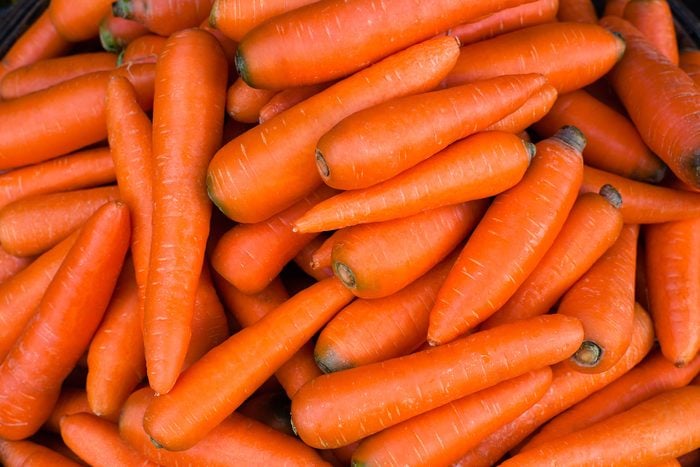 Tim UR/Shutterstock
Tim UR/Shutterstock
Can eat: Firm fruits and veggies
The biggest problem with moldy foods is that cutting away the visibly moldy sections isn't fully getting rid of the mold. For many of the moldy foods that are not safe to eat, there's a very good chance that the mold has grown deeper into the food than you think. The "roots" of the mold often expand further into many foods than what you can see. (Yuck!) But this isn't the case with "firm fruits and vegetables, like cabbage, carrots, and some pears," explains Janilyn Hutchings, a Certified Professional in Food Safety (CP-FS) for StateFoodSafety. Foods like these, as well as turnips, potatoes, and bell peppers, are still safe to eat as long as you remove the moldy spot and an inch or so all the way around it.
ⓘ
 Rawpixel.com/Shutterstock
Rawpixel.com/Shutterstock
Can eat: Certain hard, cured meats
Moldy meat may sound like a nutritionist's worst nightmare, but there are a few types of meat where mold is actually part of the deal. Hard salamis, as well as dry-cured country hams, automatically have a white surface mold. "This is not there by accident—it's a part of the manufacturing process," explains Lisa Richards, nutritionist, and creator of The Candida Diet. "This benign mold is added to the outside of the [meat] for two reasons. It helps to cure it, and it provides a protective coating to keep the salami safe from bacteria." So mold on these types of meats shouldn't scare you away. If you think you may be particularly sensitive to mold, though, Richards recommends simply scrubbing or cutting it away before consumption. Learn what happens if you accidentally eat mold.
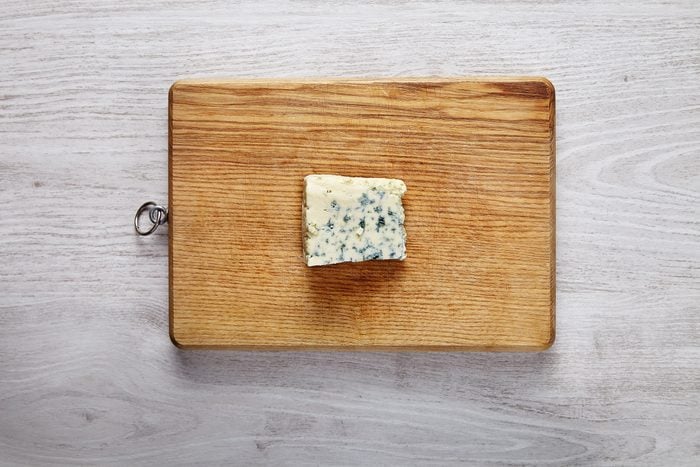 De Repente/Shutterstock
De Repente/Shutterstock
Can eat: Certain cheeses
When it comes to cheese, things can get confusing. Several different kinds of cheese are made with mold in the first place, but does that mean they're safe to eat with mold? Well, according to eatingwell.com, cheeses like Gorgonzola and Stilton, where mold is part of the process, do sometimes develop an additional small surface mold that won't harm the rest of the cheese. You're also in the clear to eat hard cheeses like Asiago and Parmesan. Similarly to the firm fruits and vegetables, hard cheeses will resist the spread of mold that would contaminate other foods. For all of these cheeses, Hutchings just recommends cutting away at least an inch around the moldy spot and discarding that, making sure that your knife doesn't come into contact with the mold. You should also check for these foods that never expire.
 De Repente/Shutterstock
De Repente/Shutterstock
Should toss: Soft or shredded cheeses
While cheeses like Parmesan can withstand a bit of mold, softer cheeses like Brie and Camembert are no good. Their softer, more liquid-y nature can facilitate the spread of mold, and with it, bacteria like E. coli, according to Katherine Zeratsky at Mayo Clinic. You should toss hard cheeses, too, if they're shredded or sliced, as these processes negate the mold buffer that a substantial block of hard cheese has. And finally, moldy cottage cheese and cream cheese have to go as well. Get a look at Mayo Clinic's full guide on which cheeses it's safe to eat moldy. See how you tell if these 10 foods have expired.
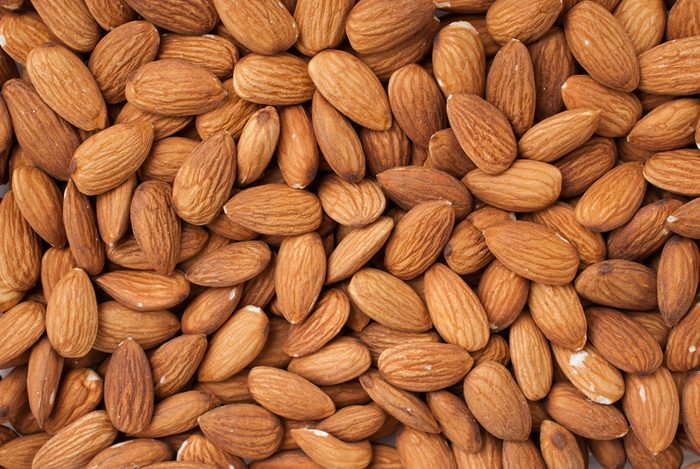 Amawasri Pakdara/Shutterstock
Amawasri Pakdara/Shutterstock
Should toss: Nuts and legumes
You might think that these foods' more solid nature, nuts in particular, might protect them against mold the same way as firmer vegetables. But the USDA's guide to moldy foods warns that foods like these, as well as nut butters, are actually at an especially high risk of developing mold because they aren't processed with preservatives.
 Moving Moment/Shutterstock
Moving Moment/Shutterstock
Should toss: Bread and pastries
You might be seeing a pattern here: Harder foods resist the infiltration of mold while softer ones are no longer good to eat. The porous nature of bread and baked goods is especially conducive to the spread of mold, per USDA. Check out the one place you haven't been checking your bread for mold.
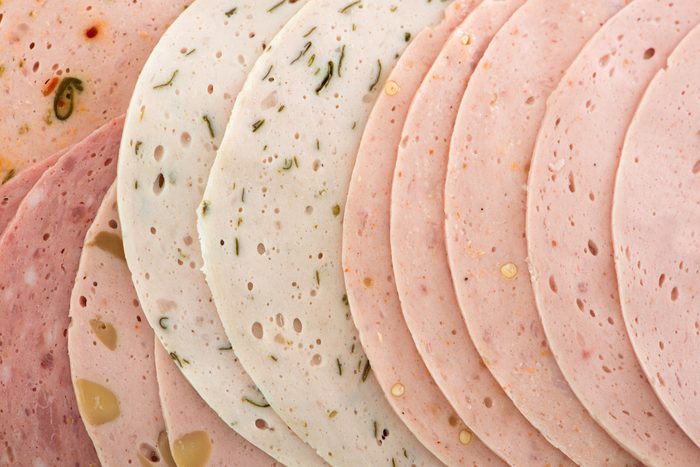 Dora Zett/Shutterstock
Dora Zett/Shutterstock
Should toss: Cold cuts and lunch meat
While the rare salami and ham use mold to enhance its flavor, mold on any other meat is bad news because of the moisture content. If your bacon, sliced cold cuts, hot dogs, or poultry have mold on them, the contamination may well have spread below the surface. You can actually freeze deli meat to make it last longer. Here's the best way to extend the shelf life of your cold cuts.
ⓘ
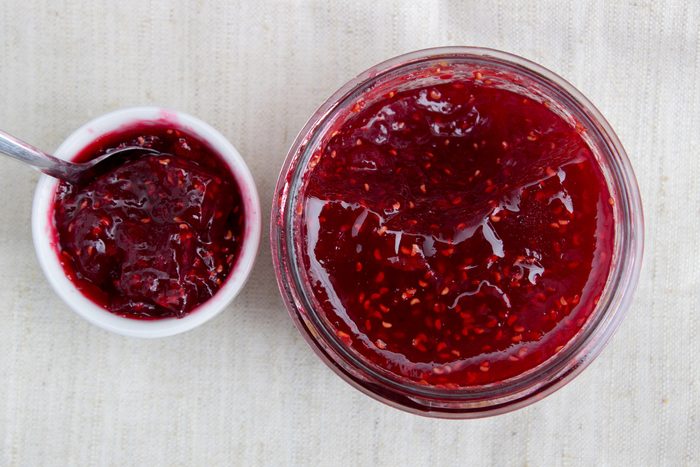 librakv/Shutterstock
librakv/Shutterstock
Should toss: Jams, jellies, yogurt, etc.
Any food with a high moisture content that's been affected by mold is bad news. This includes jelly, yogurt, sour cream, and other substances with a consistency like this that are packaged in a jar or tub. This is because the growth of mold can spread below the surface, according to the USDA. In jams and jellies, in particular, mold can also promote the growth of dangerous mycotoxins. Plus, the texture and consistency of these substances make it nearly impossible to fully remove any moldy patches, unlike more solid foods where the spot can simply be carved out. In addition to these moldy foods, there are many other foods you should never eat past the expiration date.
Sources:
- Janilyn Hutchings, StateFoodSafety
- Lisa Richards, The Candida Diet
- EatingWell: "4 Moldy Foods You Can Eat (Plus Which Foods to Toss)"
- Mayo Clinic: "If cheese has mold growing on it, should I throw it away?"
- United States Department of Agriculture: "Molds On Food: Are They Dangerous?"
- NCBI: Mycotoxins
Originally Published: November 10, 2020
Sign up for articles sent right to your inbox
Enjoy the best stories, advice & jokes delivered right to your inbox!

Subscribe & SAVE Save Up To 84%!
List of Hard Cheeses You Can Cut Mold Off
Source: https://www.rd.com/list/moldy-foods-ok-to-eat/